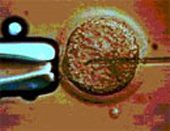Women who, for various reasons, need to use frozen eggs now have the opportunity to conceive just as effectively as those who use fresh eggs during in vitro fertilization (IVF).
 |
| Photo: manbir-online |
Advancements in “low-temperature preservation” techniques have nearly eliminated the issue of ice crystal formation that damages egg structure—a significant obstacle in traditional freezing methods. Recent results indicate these improvements have led to pregnancy rates almost equivalent to those achieved with fresh eggs during IVF.
Masashige Kuwayama from Kato Ladies’ Hospital in Tokyo, Japan, developed a technique known as Cryotop. This method involves immersing the eggs to be frozen in a solution before cooling them in liquid nitrogen. In traditional freezing techniques, eggs are exposed to protective chemicals and are gradually cooled over several hours.
In an experiment, Kuwayama successfully froze 111 eggs, with a survival rate of 94.5% after thawing. These eggs were fertilized via intracytoplasmic sperm injection (ICSI), resulting in the creation of 29 embryos, which were subsequently implanted into women. The outcome revealed that 12 women became pregnant, yielding a success rate of 41.9% compared to 42.5% when using fresh eggs. A total of 11 healthy babies were born, including one set of twins, with two pregnancies resulting in miscarriage.
The results were presented at the European Society of Human Reproduction and Embryology conference in Prague, Czech Republic, yesterday.
“This is a significant improvement. Previously, hundreds of frozen eggs would yield just one baby, but now this rate has increased tenfold“, commented Arne Sunde, former president of the association.
The traditional freezing method has been used to preserve human embryos and eggs since the 1980s, but to date, only about 150 babies have been born from those frozen eggs worldwide.
In another study, Canadian researchers demonstrated that it is possible to photograph eggs to detect chromosomal abnormalities, thereby enhancing the success rate of IVF techniques.
T. An

















































